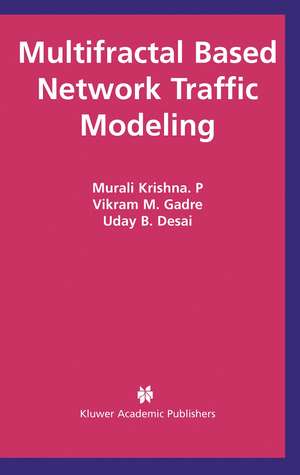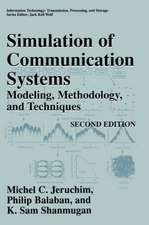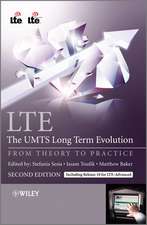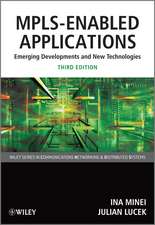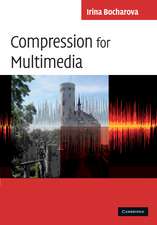Multifractal Based Network Traffic Modeling
Autor Murali Krishna P, Vikram M. Gadre, Uday B. Desaien Limba Engleză Paperback – 21 oct 2012
Graduate students, researchers, and individuals new to the areas of teletraffic modeling and communication network engineering will find this work especially helpful. The book could also be used as a textbook for a graduate level course on Teletraffic Modeling.
| Toate formatele și edițiile | Preț | Express |
|---|---|---|
| Paperback (1) | 637.78 lei 43-57 zile | |
| Springer Us – 21 oct 2012 | 637.78 lei 43-57 zile | |
| Hardback (1) | 644.82 lei 43-57 zile | |
| Springer Us – 31 dec 2003 | 644.82 lei 43-57 zile |
Preț: 637.78 lei
Preț vechi: 750.33 lei
-15% Nou
Puncte Express: 957
Preț estimativ în valută:
122.05€ • 126.70$ • 101.77£
122.05€ • 126.70$ • 101.77£
Carte tipărită la comandă
Livrare economică 24 martie-07 aprilie
Preluare comenzi: 021 569.72.76
Specificații
ISBN-13: 9781461351078
ISBN-10: 1461351073
Pagini: 240
Ilustrații: XXIV, 210 p.
Dimensiuni: 160 x 240 x 13 mm
Greutate: 0.35 kg
Ediția:Softcover reprint of the original 1st ed. 2003
Editura: Springer Us
Colecția Springer
Locul publicării:New York, NY, United States
ISBN-10: 1461351073
Pagini: 240
Ilustrații: XXIV, 210 p.
Dimensiuni: 160 x 240 x 13 mm
Greutate: 0.35 kg
Ediția:Softcover reprint of the original 1st ed. 2003
Editura: Springer Us
Colecția Springer
Locul publicării:New York, NY, United States
Public țintă
ResearchCuprins
1. Introduction.- 1 Complexity of Broadband Network Traffic.- 2 Teletraffic Modeling: Historical Perspective.- 3 Motivation for the Problem.- 4 Contributions of the Monograph.- 5 Organization of the Monograph.- 2. Mathematical Preliminaries.- 1 Random Processes.- 2 Bernoulli (Counting) Process.- 3 Poisson Process.- 3.1 Applications to Queuing Theory.- 4 Markov Process.- 5 Independent Increment Processes.- 6 Self Similar Processes.- 7 Fractional Brownian Motion.- 8 Heavy Tailed Processes.- 9 Analysis and Estimation Techniques for Self Similar Processes.- 10 Wavelet Based Analysis of Self Similar Process.- 11 The Need for Multifractal Processes.- 12 Salient points from the chapter.- 3. Broadband Network Traffic Modeling.- 1 Broadband Network Traffic Characteristics.- 2 Network Traffic Modeling Methodology.- 3 State-of-the-Art in Teletraffic Modeling.- 4 Video Traffic Modeling.- 5 Summary of Broadband Traffic Models.- 4. Multiplicative Cascades.- 1 Binomial Multiplicative Cascade.- 2 Characterizing Multifractals through Multifractal Spectrum.- 3 Methods to Estimate Multifractal Spectrum.- 4 Interpreting the Multifractal Spectrum.- 5 Generalized Dimensions.- 6 Summary of the Chapter.- 5. V.V.G.M Multifractal Model.- 1 Development of V.V.G.M Multifractal Model.- 2 Statistical Comparison Tests.- 3 Test for Robustness of the Parametric Model.- 4 Performance and Queuing Tests.- 5 Inter Departure Process.- 6 V.V.G.M and MWM : A Comparison.- 7 Salient Points of the V.V.G.M Model.- 6. Analysis of the Multiplexing of Traffic.- 1 Analysis of Multiplexing using V.V.G.M Model.- 2 Analysis of Multiplexing using Multifractal Spectrum.- 3 Analysis of the Multiplexing using Entropy.- 4 How Complex is Inter Arrival Data?.- 5 Salient points from the chapter.- 7. Modeling of VBR Video Traces.- 1 VBR Video Modeling Using Multifractals.- 2 Statistical Tests for Model Evaluation.- 3 Results of Queuing Simulations.- 4 Complexity of VBR Video Traces.- 5 Salient points from the Chapter.- 8. Qos Issues and Control of Broadband Traffic.- 1 Statistics of Multiplicative Cascade Processes.- 2 Queuing Theory for Cascade Processes.- 3 Effective Bandwidth Estimation for QoS.- 4 Estimation and Prediction of Burstiness.- 5 Salient points from the chapter.- 9. Conclusions.- 1 V.V.G.M Cascade Process for Broadband Network Traffic.- 2 Future Work.- Appendices.- A. Wavelet Transform.- B. Legendre Transform.- C. Large Deviation Theory.- D. Norros’s Queuing Model.- D.1 Parameterizing QoS Requirements.- D.1.1 Parameterizing Buffer Length.- D.1.2 Parameterizing Service Rate.- D.1.3 Parameterizing Queue Length Distribution.- E. Effective Bandwidth.- E.1 Properties.- E.2 Application in Queuing Systems.- F. Kaiman Filter.- G. Some Websites of Interest.- References.
